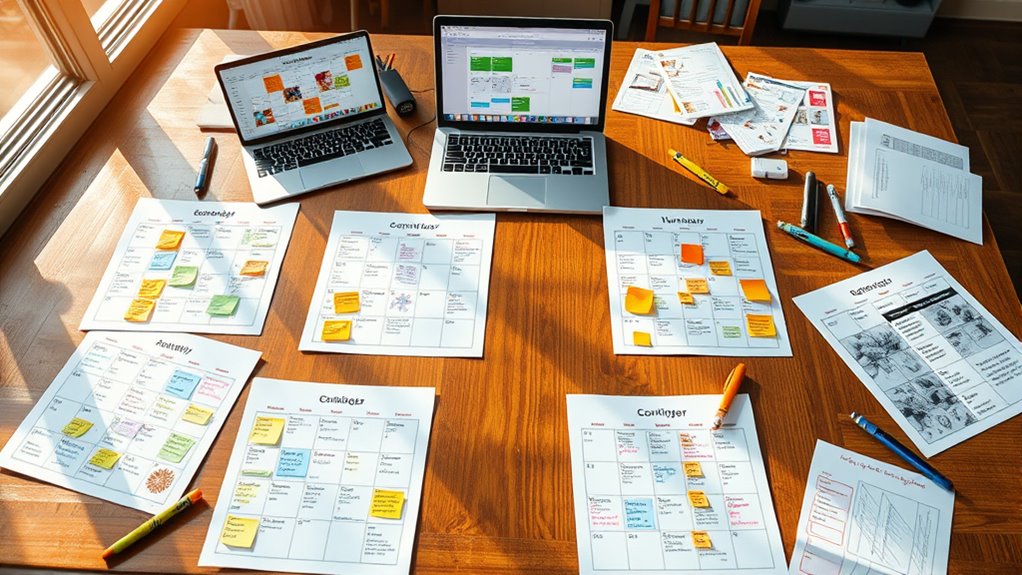To plan a year’s content in one day, start by aligning your campaigns with key seasonal dates, holidays, and trends that matter to your audience. Gather insights on audience preferences and major events, then brainstorm relevant themes and campaign ideas that resonate. Use visual tools like calendars to map out your schedule, assign tasks, and guarantee smooth execution. Keep refining your plan to stay strategic—continue to explore for tips on optimizing your seasonal campaign map.
Key Takeaways
- Identify key seasonal dates, holidays, and industry events to align content timing effectively.
- Gather audience insights and segment data to tailor campaigns for seasonal relevance.
- Brainstorm themed content ideas, promotions, and interactive campaigns based on seasonal trends.
- Create a visual calendar to map out content schedules, assign responsibilities, and track deadlines.
- Review and refine the plan, ensuring strategic alignment, clear roles, and readiness for execution.
Understanding the Benefits of Seasonal Campaign Mapping

Have you ever wondered how timing your marketing efforts can boost your results? Seasonal campaign mapping helps you do just that by aligning your content with key moments throughout the year. When you plan ahead, you guarantee brand consistency across all channels, reinforcing your message and identity. This consistency builds trust and recognition with your audience, making your campaigns more memorable. Additionally, well-timed campaigns increase audience engagement because your content feels relevant and timely. By mapping out seasonal themes and events, you can create a cohesive narrative that resonates with your audience’s interests and needs. Incorporating data-driven marketing strategies into your planning ensures your campaigns are targeted and effective. This strategic approach maximizes your marketing impact, helping you connect more effectively and achieve better results all year round.
Gathering Key Dates and Audience Insights

To effectively map your seasonal campaigns, start by gathering key dates and audience insights. Recognize upcoming seasonal trends that influence purchasing behaviors, and use audience segmentation to tailor your messaging. Understanding your audience’s interests, demographics, and behaviors helps you identify the right moments to engage them. Use the following table to organize your data:
| Key Dates | Audience Segmentation | Seasonal Trends |
|---|---|---|
| Major holidays | Age groups, locations | Fashion cycles |
| Industry events | Buying preferences | Eco-conscious shifts |
| Local festivals | Purchase history | Technology releases |
This approach guarantees your content aligns with audience needs and seasonal opportunities, optimizing campaign impact.
Brainstorming Content Themes and Campaign Ideas

What themes and campaign ideas will resonate most with your audience during each seasonal period? Focus on aligning your content with seasonal interests and needs. Use audience segmentation to tailor your messages effectively. Brainstorm campaign ideas that incorporate holiday promotions, special events, or seasonal trends. Consider these options:
- Limited-time holiday discounts and offers
- Seasonal storytelling campaigns
- Interactive contests tied to holidays
- Early bird promotions for upcoming seasons
- Themed content highlighting seasonal products or services
- Incorporate emotional connection strategies to deepen engagement and foster loyalty during each season.
Creating a Visual Calendar and Assigning Responsibilities

After brainstorming your seasonal themes and campaign ideas, it’s time to bring your plans to life by creating a visual calendar that maps out your content schedule. Use visual planning tools like calendars or project management boards to clearly see your timeline and key dates. This visual approach helps you spot content gaps and overlapping campaigns early. As you build your calendar, assign responsibilities to team members, ensuring responsibility allocation is clear. Clearly mark who’s responsible for content creation, design, approval, and publishing. This clarity keeps everyone accountable and streamlines workflow. A well-organized visual calendar not only provides a snapshot of your entire campaign but also facilitates smooth coordination, so each team member knows their role and deadlines at a glance. Incorporating insights from appliance maintenance plans can help ensure timely updates and avoid last-minute adjustments.
Reviewing, Refining, and Setting Up for Execution

Once your visual calendar is in place, it’s essential to review your planned content and timelines thoroughly. This step guarantees your content sourcing aligns with your overall strategy and deadlines. Collaborate with your team to identify any gaps or overlaps, making adjustments as needed. Focus on streamlining the workflow for smooth execution. Incorporating color accuracy considerations can further enhance the consistency and quality of your visuals.
Review your content plans and timelines thoroughly to ensure smooth workflow and strategic alignment.
- Check for consistency in messaging and branding
- Confirm deadlines and dependencies are realistic
- Reassess content sourcing to avoid last-minute shortages
- Clarify responsibilities and communication channels
- Finalize any tweaks to improve alignment and efficiency
Frequently Asked Questions
How Can Seasonal Campaign Mapping Adapt to Unexpected Market Changes?
When faced with unexpected market changes, you need to stay flexible and adapt quickly. Market flexibility allows you to shift your messaging or timing as needed, ensuring relevance. Incorporate contingency planning into your seasonal campaign mapping, so you’re prepared for surprises. By having backup plans, you can pivot seamlessly, maintaining engagement and minimizing disruption. This proactive approach helps you stay resilient and responsive, no matter what market shifts occur.
What Tools Are Most Effective for Collaborative Campaign Planning?
You might think planning is solo work, but the truth is, collaborative tools and brainstorming platforms are your secret weapons. They streamline ideas, foster real-time teamwork, and keep everyone on the same page. With tools like Trello, Miro, or Asana, you turn chaos into clarity. So, instead of working alone, leverage these platforms to create cohesive campaigns efficiently—because collaboration isn’t just nice, it’s necessary.
How Do You Ensure Content Diversity Across Different Seasonal Themes?
To guarantee content variety across different seasonal themes, you should focus on maintaining a theme balance that resonates with your audience. Mix up formats like blogs, videos, and social media posts to diversify your content. Regularly review your calendar to spot gaps in theme representation, and brainstorm fresh ideas aligned with each season. This approach keeps your content engaging, relevant, and assures a well-rounded theme balance throughout the year.
What Metrics Should Be Prioritized During the Review Phase?
You probably think reviewing metrics is just about tallying views, right? Wrong. During the review, prioritize performance metrics like conversions and reach, but don’t forget engagement indicators such as shares, comments, and click-through rates. These tell you if your content truly resonates. Keep a sharp eye on these, and you’ll spot what’s working—and what’s just noise—ensuring your campaigns stay impactful throughout the year.
How Can Teams Stay Motivated Throughout the Intensive Planning Day?
To stay motivated during an intensive planning day, focus on maintaining team motivation with regular creative energizers. Break tasks into manageable chunks and celebrate small wins to keep energy high. Encourage open communication, and remind everyone of the shared goal. Incorporating fun activities or quick brainstorming sessions can refresh the team’s mindset, helping you stay engaged and productive throughout the day. Keep the momentum going with positive reinforcement and collaborative spirit.
Conclusion
Think of your seasonal campaign map as a carefully crafted garden. With each date and idea planted thoughtfully, your content blooms at just the right time, attracting and delighting your audience. When you plan a year’s worth of content in a day, you’re tending to this garden with purpose and foresight. As seasons change, your brand blossoms effortlessly, creating a vibrant, thriving landscape that keeps your audience engaged and enthusiastic for what’s next.
Natali – Editor in Chief (Strategy and Mastery, AI Expert) Natali, our Editor in Chief, is the driving force behind our content’s strategic direction. With a keen eye for detail and a deep understanding of market trends, Natali ensures that our content is top-notch and strategically aligned with our client’s goals. Her expertise in AI helps to seamlessly integrate advanced technology into our marketing strategies, pushing the boundaries of conventional marketing.










